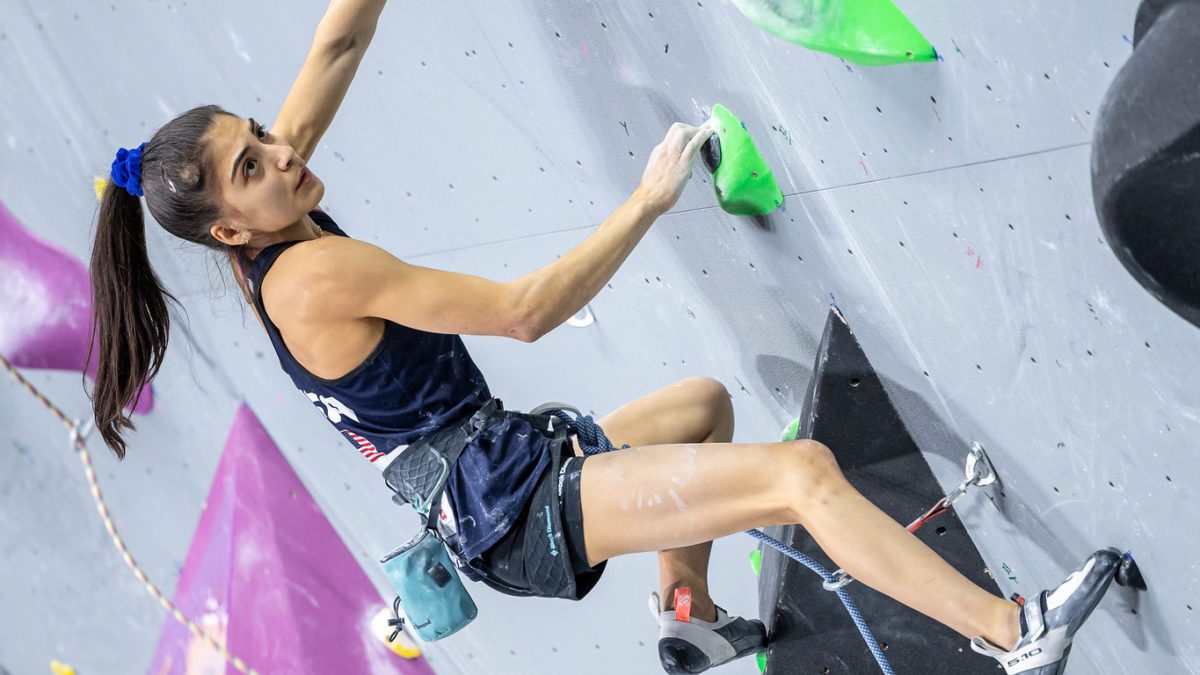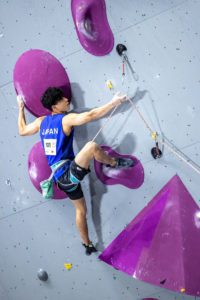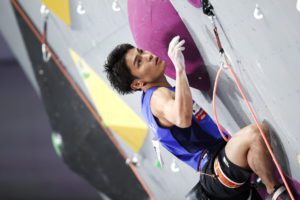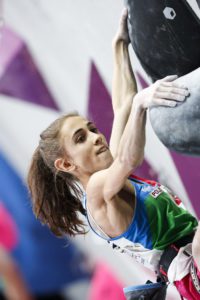Three Way Tie Leading into Finals
Three women secure a top at Moscow's Lead World Championships, while the youngest athlete in the Men's field secures first position heading into finals

Early this morning, Canadians awoke to Moscow’s Lead semi-final. The rugged routes of the round threw athletes at Sport Climbing’s season-ending event: the Lead World Championships.
Climbing alongside one another, men and women pushed themselves up the bouldery sequences describing each of the semi-final routes. In either category, most every athlete appeared on form, without a single athlete falling low on the intense climbs.

Men
First out for the men, Germany’s Martin Philipp pulled onto the gib-intensive route. Where gibbing could suggest some sort of positive rest in another competition, the gripping climb prevented athletes from stopping. As many already competed in the Boulder World Championships over the previous days, this sort of difficulty tested climbers and their ability to endure fatigue.
Philipp climbed well through the first sections of the route, both entering and exiting the yellow grips that concluded the bottom third. Upon entering the second crux, Philipp fell slapping from a thick pinch to a gibbed volume. His attempt placed him near the bottom of the field in what would become a tight competition.
At 26+, Philipp finished his season in 22 position. Had he gained even two more holds, he would have finished 17. The athletes’ proximity to one another persisted everywhere with three of the top four finishing only a (+) ahead of the fifth and sixth placed athletes. Second through fourth tied at 40+, where first saw a decisive Top of the route.
The separation in the men’s field came out well, however a time-based tie-break may have to occur if two of these 40+ athletes walk away with the same score.

As the round progressed, the competitors moved higher through the green holds of the upper crux. Entering a crimpy no-shadow sequence at the top of the wall, Italy’s Stefano Ghisolfi blazed his trail up the tiny grips. Few would match his high point.
Ghisolfi became the only athlete that qualified relatively low in the first round that ultimately made it into finals. After a consistent season that earned him a World Cup gold medal, his making finals today was expected.
Germany’s Sebastian Halenke joined Ghisolfi at 40 holds and took fifth to Ghisolfi’s sixth based on countbacks. Halenke’s return to competition has become something to watch as he made podium in Kranj only weeks ago. Today he makes finals at the World Championships with the capacity to do a lot more this afternoon.
In similar recent consistency, Slovenia’s Luka Potocar replicated his strong performance in Kranj today on Moscow’s stage. Making a (+) movement beyond Halenke, Potocar took third heading into finals. Olympic bronze medalist Jakob Schubert joined Potocar as did the Czech Republic’s Martin Stranik.

After such strong Lead seasons, these results also fail to surprise. Their consistency this year has shown them to be two of the strongest on a rope, despite their being two of the oldest competitors in the IFSC.
With that said, the round was far from ordinary. Japan’s Yoshiyuki Ogata climbed a phenomenal competition and reached eighth position after a series of difficult moves. The incredibly strong boulderer climbed well and clearly gave his full effort in the achievement of this position. It was a special run. His teammate, Tomoa Narasaki ultimately concluded the event in seventh. He appeared to fall after misreading beta and less because of a lack of stamina.
In the end, the best result of the morning went to Hamish McArthur. Not only did the young British athlete win the Youth Boulder and Lead World Championships, but he took seventh in Open boulder and has shown incredible consistency in this last month. He will enter finals in first.

Women
In the women’s field, athletes moved through a similarly sustained series of moves. Ukraine’s Ievgeniia Kazbekova came out first and climbed well through a less intense bottom sequence. She then entered and executed the route’s first crux.
A Cheeta-heavy boulder problem pulled Kazbekova through a confusing foot-based technical sequence that revolved around a heel or toe-hook depending on the climber’s decision. Kazbekova moved through this sequence with ease, though many athletes become so confused that they had to down climb to reassess.
A fibreglass-heavy compression sequence then greeted the Ukrainian who fell afterwards heading to a crimp. A foot-pop placed her in 17.
Despite her relatively low score, Kazbekova maintained a high position for much of the competition. Still, she soon fell to second. Japan’s Natsuki Tanii climbed well beyond Kazbekova’s high-point and moved through to the crux of the route. This yellow sequence of holds reflected the men’s upper section in its gib heavy construction. Attaining a rest, Tanii shook out on smallish holds before entering a heel-based standing sequence. Slapping for a scoop, Tanii fell and concluded her round in fifth.

France’s Salomé Romain would then enter the field several competitors later. Although she did not dethrone Tanii, she climbed well and moved into sixth.
Austria’s Jessica Pilz soon joined Romain, climbing into fourth position by matching Tanii’s high point. At 41(+), no athlete climbed higher than these two without topping the route. As such, most who followed made up the top three, but not before Russia’s Dinara Fakhritdinova entered the field.
Fakhritdinova had a strong season this year, climbing into finals in both Chamonix and Kranj. By taking eighth in Moscow, she will move onto finals again.
Those who concluded the round almost all made finals. First, American Brooke Raboutou climbed into seventh place, falling in an attempt to match a stumping left hand. Soon after, her teammate Natalia Grossman climbed all the way through the Top of the climb. In doing so, Grossman showcased one particular movement that took her into an extremely deep lock-off. From that point on, it seemed unlikely that she would fall.

Italy’s Laura Rogora came up with a beta all her own and skipped the move that Raboutou fell on. In doing so, Rogora also topped, followed by Korea’s Chaehyun Seo. This proximity of ability within the top of the field does become difficult to separate, however, with three women topping the semi-final route, finals will have to be more difficult.
Should separation not occur, and all three athletes top again, the conclusion of the Lead World Championships would be separated by time to high point. This unsatisfactory result shouldn’t occur as the routesetters have worked well over this Championships, however, the regularity of this problem will eventually require a solution. This occurred in both Chamonix and Briançon and only in the women’s field. The sport seems to need more international-level female route setters.
Result
Men Advancing to Finals
1 – Hamish McArthur (GBR)
2 – Jakob Schubert (AUT)
3 – Luka Potocar (SLO)
4 – Martin Stranik (CZE)
5 – Sebastian Halenke (GER)
6 – Stefano Ghisolfi (ITA)
7 – Tomoa Narasaki (JPN)
8 – Yoshiyuki Ogata (JPN)
Women Advancing to Finals
1 – Chaehyun Seo (KOR)
2 – Natalia Grossman (USA)
2 – Laura Rogora (ITA)
4 – Jessica Pilz (AUT)
5 – Natsuki Tanii (JPN)
6 – Salomé Romain (FRA)
7 – Brooke Raboutou (USA)
8 – Dinara Fakhritdinova (CFR)
Featured image of Natalia Grossman by Jan Virt


